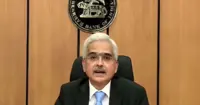Whose rally is it anyway?
23 Feb 2006
Now that we are well and truly into 2006 and the heady hangover of the 2005 returns has waned, it's possible that many of us may wish for an encore. Who wouldn't? If the arguments that held well, through much of 2005 are indeed valid for 2006, then it might seem that the stock market will rally through the year 24 x 7 x 365. If only it were that simple.
If one reads what's commonly written in newspapers, spoken on the idiot box, and heard over cocktails, then one could be forgiven into believing that the good times would never end. And it is not our brief to remotely suggest that they should or shouldn't do so for good. The arguments are common — liquidity is too much, FIIs' love affair with India is permanent, India is the cock of the walk of the emerging markets, domestic investors have no other alternative to equities, and so on.
For the last few years, not until this bull market started, Indians have been selling off stocks rather cheaply to foreigners, which on hindsight now seems to have been a foolish thing to do. So much so that FII holdings in domestic companies is 24 per cent — higher or equal to that of public investors in the top 50 companies. Now after the market has trebled in size and value, the same domestic investor is funneling his savings back into the market effectively buying back the stock at significantly higher prices than at which they were sold, enabling the FIIs to pocket a windfall.
While the domestic investor seemingly has no alternative, whenever the TINA factor (There Is No Alternative) has played out, there has been a heavy price to pay. If Mr. Rajiv Gandhi were alive, he would have told us how the TINA factor cost him the hot seat in Delhi. Investing is much the same psychologically.
In investing there is always an alternative that very few astute investors use judiciously. It is called cash. Until yesterday, domestic investors were happy parking their savings in staid bank deposits and RBI bonds, equivalent of cash one might say, when the rest of the world was buying stocks.
Now they seem to be doing the reverse. The last time this happened the consequences were horrible to say the least. Yes, we are alluding to the "technology bubble". Around that time mutual funds launched innumerable schemes to invest in the technology and media sectors only to see the money vanish and along with that their investors.
While we are far from a bubble-like situation in the market as a whole, the similarities are striking. Mutual funds are raising money as if there will be none to be found after a month. Investors a pouring in money into them as if there will be no stocks to buy after a month! This frenzy obviously accompanies tops and a short to medium term correction invariably follows such periods of mass frenzy.
Union budgets — whose rally is it anyway?
The Union Budget is around the corner and the annual air of expectations is back. Finance ministers don the mantle of Santa Clause, hoping against hope to hand out enough all around but seldom succeed that result is a post-budget dejection.
While every attempt is made to co-relate stock markets with the budget, the connection snaps inevitably within weeks, sometimes a few months. The last two budgets have basically done little that could have directly impacted equity valuations, or bolstered growth. The rally on the stock market in both years is despite suffering through two of the most insipid budgets.
The government including, sadly the PMO, and the finance ministry has singularly lacked gumption to take on the incalcitrant Left parties, resulting in impotency that would make even a 60-year Casanova proud. Whose rally has it been anyway?
How long can this government remain flaccid?
But somebody somewhere has seen through this consistent feeble policy response of this government. It was Calpers, the powerful global fund house, that has given India a tight rap on the knuckles by downgrading its investment standing for 2006, citing this very reason for doing so.
Now, if some more foreign investors were to begin getting vocal about their displeasure, then this chorus will almost certainly lead to a significant shift in thought and action on the stock market, its valuations and of course its interim direction.
Also note, that while this government can take very little credit for this bull run, it's a tacit admission of this fact that has led it to show such nonchalance towards it this past year. This government has felt even less obligated to act since the bull market has happened inspite of it. The dictum in South Block seemed to be - if it ain't broke, why fix it!
How long such flaccidity will be acceptable by foreign investors and in fact but all of us Indians too, is a moot point. Is it enough to have astute men at the helm of affairs that despite their intellect and desire lack the courage to brush aside political considerations and do what should be done? In a strange way should they not act now, then in future the country will have to bear the burden of history.
Is Union Budget 2006-07 that moment of reckoning?
For far too long have strategists and market intelligentsia lamented about the lack of initiative in fiscal correction, the massive combined fiscal deficit, inaction on labour reforms, sub-optimal spending on infrastructure, lack of accountability on rural development populist schemes, and so on. That stock markets have remained indifferent to this too is a matter of some concern for this long. Will we have another burdensome Budget that lacks the dentures to bite the bullet? Or one that will put politics on the back burner for once and do what perhaps only two other Budgets have ever done in the history of this country. February 28th should provide us with some serious answers.
The 2-year cycle is back. Alive and ready to kick!
In the stock market, a week may be too short to change the course of the recent stock market history. But a month is often enough to do so. While we are not suggesting a hark back to the gloom of a bear market, the two-year cycle in the Indian stock market has often nailed the tops and bottoms of markets. That in itself should make investors wary and take its presence with more than a modicum of importance.
The finding of this two-year cycle must go to our good friend Vivek Patil, arguably the best Elliot Wave analyst in the country by our admission. He points out that this March will fall on the two-year cycle. The following chart shows this cycle. All the major tops and bottoms in the Sensex's history have happened closer to every alternate March, plus or minus 1 or 2 months.
In the last 20 years, crucially, the market has topped out in the first quarter, leading to a significant decline in the subsequent months. Although the market may have rallied later in the year, the top has been of at least intermediate significance. This period has marked seven tops of which all four major tops of the last 20 years fell in this time window, the rest being intermediate tops. Of the three bottoms, only one may be called a major bottom. The bottom of this bull market incidentally can be marked at 2904 in April 2003, an intervening year but still almost within the time window! (See accompanying table)
| The two-year cycle : Its back. | |||
| Year | Month | Sensex | Top / Bottom |
| 1986 | February | 665 | Major Top |
| 1988 | February | 399 | Major Bottom |
| 1990 | February | 659 | Intermediate Bottom |
| 1992 | April | 4546 | Major Top |
| 1994 | March | 4299 | Major Top |
| 1996 | February | 2823 | Intermediate Bottom |
| 1998 | April | 4322 | Intermediate Top |
| 2000 | February | 6150 | Major Top |
| 2002 | February | 3758 | Intermediate Top |
| 2004 | March | 6955 | Intermediate Top |
| Alternate years since 2000 | |||
| 2001 | February | 4462 | Intermediate Top |
| 2003 | January | 6249 | Intermediate Top |
| 2005 | January | 6696 | Intermediate Top |
| Note : Sensex value is the monthly high | |||
In this decade too, the year 2001, 2003 and 2005, all intervening years, had important tops generated in the same time window suggesting that the market reached a crescendo of emotion that inevitably results in a catharsis (or sometimes joy too!) subsequent to the union budget.
So as we move closer to February 28th, we get this ominous sense offoreboding that, perhaps, time is indeed running out for the market and that the burden of history will indeed be too heavy to shake off.
*The author is head, potfolio management services and investment advisory, IL&FS Investsmart Limited.
.webp)

.webp)

.webp)


























